Depth of field of Security video camera
This chapter mainly discusses the depth of field of the lens. For other parameters of the lens, please refer to the lens section.
The depth of field of the lens is an important concept, which affects the effect and quality of video imaging. In practical applications, both P-iris and i-CS lenses can better present the image imaging effect by controlling the depth of field. This is regarded as the concept of depth of field. An application case in the field of security. In practice, the application of static photography such as photography may pay more attention to the depth of field, which will be discussed later.
Definition
Like the photography industry, the lens used in security cameras is also a convex lens. Let’s first look at a few concepts about convex lens imaging:
Focus
When the light parallel to the optical axis enters the convex lens, the ideal lens should concentrate all the light at one point and then spread it out in a cone shape. This point where all the light is gathered is called the focal point.
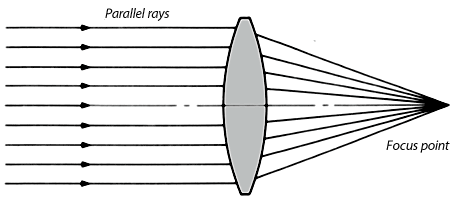
Circle of confusion
The point light source passes through the lens to form a point in the focal plane. Keep the distance between the lens and the film unchanged. Move the point light source back and forth along the optical axis. The image formed on the image plane will become a circle with a certain diameter. The diameter of the image is small enough to still look sharp enough in the photo. If the circular image of the point light source is larger, the photo will appear blurred. This circular image of the critical point light source is the circle of confusion, also known as the circle of confusion.
In reality, the captured image is viewed in a certain way (such as projection, magnification into a photo, etc.). The image felt by the naked eye has a great relationship with the magnification, projection distance and viewing distance. If the diameter of the circle of confusion is greater than the discriminative ability of the human eye, the blur produced by the actual image within a certain range cannot be recognized. This unrecognizable circle of confusion is called the permissible circle of confusion.
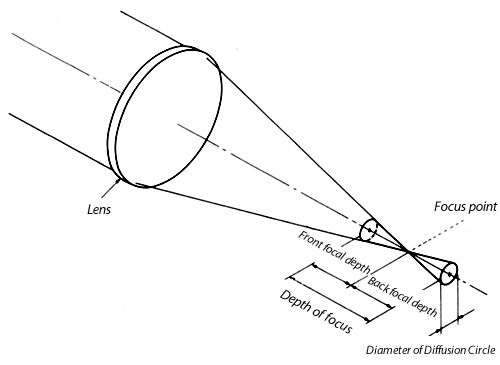
In security cameras, the sensor is equivalent to the human eye, and the size of the sensor is similar to the discrimination ability of the human eye. This means that if the size of the circle of confusion is smaller than a single sensor unit, the image can be clearly imaged. The larger the sensor, the larger the diameter of the circle of confusion that can be tolerated.
Depth of field
There is a permissible circle of confusion before and after the focal point. The distance between these two circles of confusion is called the depth of field, that is: before and after the subject (focus point), the image still has a clear range, this clear range is Depth of field. In other words, the front and back depth of the subject and the degree of blurring of the image presented on the screen are all within the limit of the permissible circle of confusion.
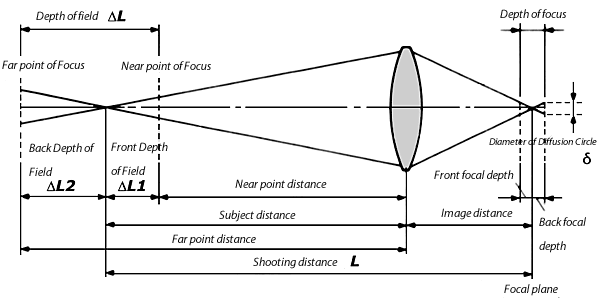
Calculation of depth of field
Depth of field calculation formula
δ: Allowable circle of dispersion diameter
f: lens focal length
F: lens aperture
L: Shooting distance
Front Depth of Field ΔL1
Back Depth of Field ΔL2
Depth of Field ΔL
Among them, the Back Depth of Field> the Front Depth of Field.
It can be seen from the calculation formula of the depth of field that the depth of field is related to the lens aperture, focal length, shooting distance and the size of the permissible circle of confusion. As analyzed above, the size of the circle of confusion is determined by the sensor size, so when a camera with a certain solution (known sensor size), its depth of field is mainly affected by the lens aperture, focal length and shooting distance.
From the calculation formula of the depth of field, it is not difficult to see:
- The larger the aperture, the smaller the depth of field; the smaller the aperture, the greater the depth of field;
- The longer the focal length of the lens, the smaller the depth of field; the shorter the focal length, the greater the depth of field;
- The farther the distance, the greater the depth of field; the closer the distance, the smaller the depth of field.
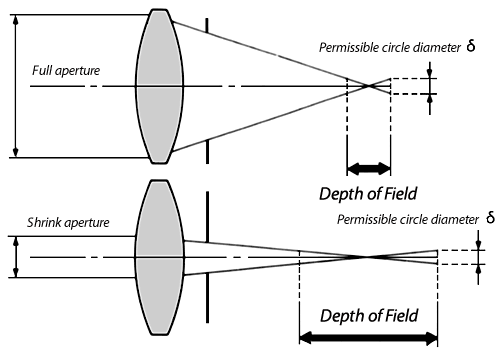
Depth of field online calculation tool
In the photography industry, professional cameras or lenses are generally marked with the depth of field. At the same time, there are some online depth calculation tools on the Internet, which can calculate the depth of field more conveniently.
Depth of field online calculation tool provided by ipsecu.com.
Depth of field in Security
The focus of the above analysis is in the field of professional photography, which are generally static images. Back to the security field, video surveillance cameras are used for real-time monitoring, not for shooting static images. In the surveillance scene, people and vehicles are moving in real time, and the focus point is actually constantly changing, so that the range of depth of field changes is greater. From the perspective of depth of field, for a security camera with a known focal length, we can determine a monitoring range, within which the image is clear.
In any focal length condition, for security monitoring, the greater the depth of field, the better, which means that in a limited monitoring area, the image must always be clear.
On the other hand, it is necessary to pay attention to the optimal viewing range of lenses with different focal lengths. This needs to be considered comprehensively through the resolution of the camera and the purpose of monitoring (detection, monitoring, identification, etc.). The best viewing distance of a general 2.8mm lens is 3-6 meters. If we set the target at 10 meters and can’t see anything, it will lose the meaning of monitoring. The visual range of the 3.6mm lens is about 6-10 meters, the 6mm lens is 10-15 meters, and so on.
For security camera manufacturers, through the depth-of-field calculation formula, when the focal length is known, it can calculate how far the reference object is used, so that the camera can adjust the lens focal length to the best position when it leaves the factory.
We use this online depth-of-field calculation tool, for example. Choose the more commonly used configuration of security cameras, such as camera sensor target surface 1/3’, lens aperture f/1.4, lens focal length 3.6mm. If the distance of our reference object is 2 meters, we know by calculation that at this time: the front depth of field is 0.6 m, and the back depth of field is infinite. Obviously this 2 meters distance is appropriate. At least 0.9 meters or more can make the depth of field reach infinity. So when we debug the 3.6mm lens, the test reference target must be at least 0.9 meters above.
Through the same calculation, the reference target distance of the 3mm lens should be more than 0.6 meters, the reference target distance of the 4mm lens should be more than 1.1 meters, the reference target distance of the 6mm lens should be more than 2.4 meters, and the reference target distance of the 8mm lens should be more than 4.3 meters.
Among them, pay special attention to the case of a relatively large focal length, such as a 6mm lens. If the reference target distance is 2.2 meters, the depth of field is 27.1 meters at this time. This distance has exceeded the visible distance of the 6mm lens. Through the previous analysis, the optimal monitoring distance of our 6mm lens is 10-15 meters, and the depth of field of 27.1 meters can fully meet our needs. So we try to shorten the reference target distance. When the reference target distance is 2 meters, the depth of field is 11.3 meters, which is just the limit of the range of 10-15 meters. Therefore, for the 6mm lens, referring to the shortest distance of the target, we choose 2 meters to be better than 2.4 meters.

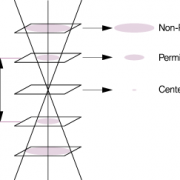


Leave a Reply
Want to join the discussion?Feel free to contribute!